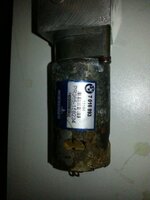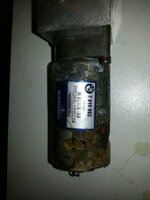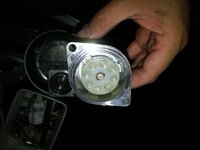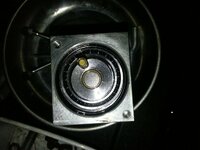...familiar story (except the bring back to life bit) I spent just a few hours getting the roof off, prising the rusted, soggy motor out, then baking it in the oven for ten minutes on a low heat, slapping it back in and voila working roof, in fact a roof that is twice as fast as it was before, so result.
Ok, so add in the taking the roof off again as I'd switched the power leads, the grazed knuckles from trying to prise the power connections apart, the cricked neck from performing yoga in the boot much to the merriment of the neighbours, but ultimately for just a few hours mucking about in the sunshine I now have a roof operation that works properly and hopefully with the couple of mods I did to the motor's jacuzzi to aid drainage it won't happen again.
So before you bin that rusty hunk of metal that used to be a roof motor, consider salvaging it, baking it and spraying in half a can of WD40 before binning it so readily.... :driving:
few pics as requested:
Hmm, with all that algae and the 6" of water in the drain it doesn't look promising, let's hope BMW's finest really thought about this...

...Looks like BMW's finest were on holiday and the bean counters designed the water proofing after all.

Still, a quick 10 minute bake in foil after a WD40 shower will sort most motor ills

Quick test on the very expensive roof test rig and we're almost ready for a refit

Just fit this over the motor side drain plug to keep any large debris at bay and hold the motor housing away from the hole allowing free flow of water.

In place sitting over the drain plug, the motor housing bears down on the ring holding in place:

Image of one of the test rig legs, width of each 'foot' is approx 4ft, with the height of each leg being 2ft. Good use for surplus decking boards

Quick video showing the roof testing before fitting back in the car:
[youtube]Cm01Jcws_o4[/youtube]
Ok, so add in the taking the roof off again as I'd switched the power leads, the grazed knuckles from trying to prise the power connections apart, the cricked neck from performing yoga in the boot much to the merriment of the neighbours, but ultimately for just a few hours mucking about in the sunshine I now have a roof operation that works properly and hopefully with the couple of mods I did to the motor's jacuzzi to aid drainage it won't happen again.
So before you bin that rusty hunk of metal that used to be a roof motor, consider salvaging it, baking it and spraying in half a can of WD40 before binning it so readily.... :driving:
few pics as requested:
Hmm, with all that algae and the 6" of water in the drain it doesn't look promising, let's hope BMW's finest really thought about this...

...Looks like BMW's finest were on holiday and the bean counters designed the water proofing after all.

Still, a quick 10 minute bake in foil after a WD40 shower will sort most motor ills

Quick test on the very expensive roof test rig and we're almost ready for a refit

Just fit this over the motor side drain plug to keep any large debris at bay and hold the motor housing away from the hole allowing free flow of water.

In place sitting over the drain plug, the motor housing bears down on the ring holding in place:

Image of one of the test rig legs, width of each 'foot' is approx 4ft, with the height of each leg being 2ft. Good use for surplus decking boards

Quick video showing the roof testing before fitting back in the car:
[youtube]Cm01Jcws_o4[/youtube]



